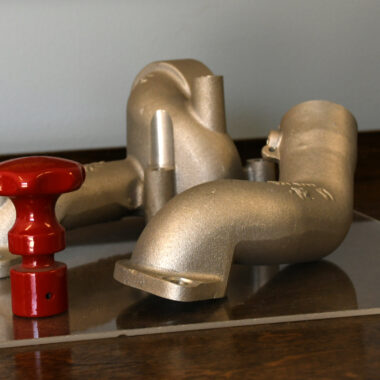Crafting Luster: Navigating the Globe About Aluminum Casting
Wiki Article
Explore the World of Aluminum Spreading: Expert Keys and Approaches
In the realm of production, aluminum spreading stands as an essential process, critical for the development of a broad selection of products. As we browse with the globe of aluminum spreading, there exists a realm of expert secrets and approaches that can elevate the top quality of the final items and streamline the manufacturing process.
The Essentials of Light Weight Aluminum Spreading
Light weight aluminum casting, an essential process in manufacturing, involves the putting of liquified light weight aluminum into a mold to achieve wanted forms and frameworks. This functional strategy is commonly used across numerous sectors due to light weight aluminum's phenomenal residential or commercial properties such as high strength-to-weight ratio, deterioration resistance, and thermal conductivity.The procedure begins with the melting of light weight aluminum in a heater at temperatures exceeding 1220 ° F(660 ° C ) As soon as the aluminum reaches its fluid state, it is poured into a pre-designed mold and mildew cavity. The mold and mildew, normally made from materials like steel or sand, determines the last shape of the actors aluminum part.
After putting, the aluminum is left to strengthen and cool within the mold and mildew - about aluminum casting. This cooling period is critical as it figures out the integrity and quality of the last product. When solidified, the mold and mildew is removed, disclosing the recently formed light weight aluminum spreading
Insider Tips for Effective Casting
To achieve optimal outcomes in light weight aluminum spreading, thorough focus to information throughout the mold style phase is crucial for making sure effective results. Monitoring and controlling the steel temperature level throughout the spreading process can help prevent concerns such as early solidification or porosity in the final product.A well-prepared mold and mildew surface can contribute to far better metal circulation, decreased disturbance, and improved surface area coating on the cast component. By paying close attention to these expert pointers, makers can boost the high quality and performance of their aluminum casting processes.
Advanced Techniques in Light Weight Aluminum Spreading
Using advanced techniques and innovative techniques, the realm of aluminum spreading has actually seen a significant development in the direction of progressed techniques that push the limits of standard techniques. One such technique is vacuum casting, which includes developing a vacuum cleaner setting to remove air from the mold cavity, resulting in greater high quality and even more detailed spreadings with lowered porosity. In addition, investment casting, also called lost-wax casting, is a refined approach that enables complex shapes and slim wall surfaces, leading to in-depth and exact aluminum parts.
Additionally, progressed simulation software program plays an important duty in maximizing casting styles and anticipating possible issues, allowing for adjustments to be made before the actual casting process starts. By accepting these sophisticated methods, makers can boost their light weight aluminum casting capacities to brand-new elevations, fulfilling the needs of modern-day sectors with browse around this web-site accuracy and advancement.
Recognizing Various Casting Techniques
In the world of manufacturing, a detailed understanding of different casting techniques is vital for accomplishing optimal results in steel manufacture procedures. Different casting methods supply one-of-a-kind benefits and are chosen based on factors such as the intricacy of the style, production volume, product demands, and cost considerations. Among the most common spreading techniques why not try this out is sand casting, where a mold and mildew is produced utilizing sand as the primary product. Sand casting is versatile, cost-efficient, and suitable for generating big parts.One more prominent spreading approach is pass away spreading, which involves injecting molten metal into a mold cavity under high pressure. By comprehending the nuances of different casting techniques, makers can make enlightened choices to maximize their manufacturing procedures and accomplish the preferred results.
Making Best Use Of Efficiency in Spreading Procedures
With a strong understanding of the nuances of various casting approaches, makers can improve their procedures to improve performance in metal fabrication procedures. Taking full advantage of efficiency in casting operations calls for a methodical approach that concentrates on optimizing every step of the spreading process.In addition, buying sophisticated modern technology and devices can significantly boost efficiency in casting procedures. Automated systems, robotics, and computer-aided layout (CAD) software application can streamline processes, lower errors, and boost result. Additionally, training workers on the most up to date methods and ideal techniques can also add to maximizing effectiveness in casting procedures.
Normal maintenance of equipment and tools is vital to prevent break downs and lessen downtime - about aluminum casting. Executing a positive upkeep timetable can aid recognize possible issues before they escalate, guaranteeing smooth operations and continuous production. In general, by prioritizing effectiveness and constant enhancement, makers can enhance their casting operations and stay competitive in the industry

Verdict
In final thought, the world of light weight aluminum casting offers a vast variety of opportunities for those looking to develop durable and complex metal things. Comprehending the various spreading methods and maximizing efficiency in procedures are essential parts to accomplishing high-quality outcomes in aluminum spreading.
One such technique is vacuum spreading, which involves developing a vacuum atmosphere to remove air from the mold dental caries, leading to higher high quality and more elaborate spreadings with decreased porosity (about aluminum casting). In addition, investment casting, additionally known as lost-wax casting, is a polished approach that allows for complicated forms and thin walls, resulting in exact and detailed aluminum components
One of the most typical spreading approaches is sand casting, where a mold and mildew is developed utilizing sand as the key material.One more preferred casting approach is pass away spreading, which involves injecting liquified metal into a mold and mildew cavity under high this hyperlink stress. Comprehending the numerous casting methods and maximizing performance in operations are crucial components to accomplishing high-grade outcomes in light weight aluminum casting.
Report this wiki page